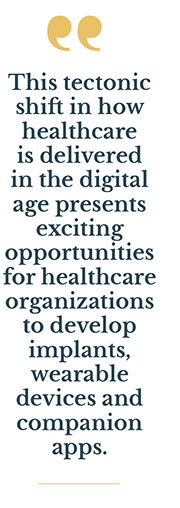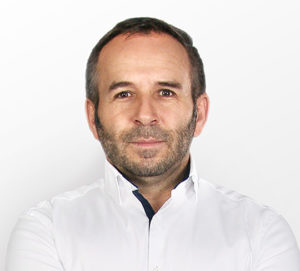Though chronic diseases are growing in prevalence, monitoring vital signs has proven effective in improving outcomes and empowering patients to manage their routine healthcare more effectively. This tectonic shift in how healthcare is delivered in the digital age presents exciting opportunities for healthcare organizations to develop implants, wearable devices and companion apps.
Pandemic-related disruption, the prevalence of chronic diseases, and patients increasingly managing their own healthcare have all accelerated digital advancements in the field.
Just as necessity is the mother of invention, the recent rush of digital advancement across the Healthcare and Medical Technology sector these past few years can be traced back to the Covid-19 pandemic.
When traditional in-office visits were no longer advisable or even possible, telehealth solutions leveraging Internet-based devices provided a way for doctors to still be able to track their patients’ health. The use of telehealth solutions more than doubled as a result.
The growing prevalence of chronic diseases and the growing number of patients managing their own healthcare have both further accelerated digital advancement.
Portable wearable devices are enabling physicians to remotely monitor a patient’s blood pressure, heart rate, blood sugar levels, oxygen saturation and other parameters related to their specific medical condition.
 New diagnostics applications that leverage the power of AI and machine learning are creating new opportunities and advancement in the Medical Technology space. Collectively, these events have propelled digital health utilization to new heights, creating both challenges and opportunities throughout the industry, with the expectation of a lasting impact.
New diagnostics applications that leverage the power of AI and machine learning are creating new opportunities and advancement in the Medical Technology space. Collectively, these events have propelled digital health utilization to new heights, creating both challenges and opportunities throughout the industry, with the expectation of a lasting impact.
One of the uses of AI is to help companies improve their ability to make data-driven business decisions associated with new product launches and adoption. The continual advancement and application of AI and ML to analyze and extract useful and actionable information from all data collected from CRM or ERP systems and industry analytics to assess product adoption have initiated a spiral of progress. The more these “smart” algorithms are developed and refined, the more devices will be used. And more devices translate into more high-quality data being generated to facilitate the further development of ML and AI algorithms.
Data collected in this way also removes the bias traditionally present in medical data. Often, people receiving tests (and generating data) in a clinical environment present symptoms of some condition. This means that the medical data may be biased toward symptomatic people rather than asymptomatic (i.e., healthy) people. Diagnostic programs will be able to identify these differences and provide a much better understanding of a population’s health as a whole.
Specialized clinicians and nurse practitioners focused on managing a patient’s disease condition use dedicated disease diagnostic applications.
In the case of heart failure, for example, a patient might have an implantable cardiac device that provides daily feedback to the patient, caregiver and clinician through a variety of sensors or device inputs, along with a patient diary that captures the patient’s daily information.
The data gathered might trigger any of a set of alerts to notify the nurse practitioner or clinician when the patient is approaching a pre-set level, thereby facilitating a patient physical visit, patient telehealth visit, or other appropriate interaction.
Producing actionable information from a variety of data sources requires the integration of numerous applications or subsystems. These can include embedded software, medical devices, secure communications, mobile applications and cloud systems.
As a result, disease diagnostic application developers will require expertise in data integration, interoperability, security and the ability to find and utilize the islands of data that currently exist in healthcare systems.
 As imaging technologies have evolved from x-rays to high resolution PET/MRI, there’s an explosion in the amount of data being collected and analyzed manually by clinicians. Given the rapid increase in the amount of image data collected per patient today versus ten years ago, there is a need to build decision support tools to help the clinicians diagnose, treat and assess cases in more precise ways. Imaging is an ideal candidate for implementing AI/ML technologies. The primary component of image analysis is pattern recognition, which machines are very good at.
As imaging technologies have evolved from x-rays to high resolution PET/MRI, there’s an explosion in the amount of data being collected and analyzed manually by clinicians. Given the rapid increase in the amount of image data collected per patient today versus ten years ago, there is a need to build decision support tools to help the clinicians diagnose, treat and assess cases in more precise ways. Imaging is an ideal candidate for implementing AI/ML technologies. The primary component of image analysis is pattern recognition, which machines are very good at.
Some good examples are:
- Cancer Detection & Classification – an AI-based tool for the detection and segmentation of small nodules of a lung from a CT scan to diagnose cancer in early stage. Nodules classification with high accuracy helps with diagnosis and the following treatment planning and assessment.
- Knee joints Localization and Segmentation – Creating a pipeline to extract joints from X-ray images using developed Machine Learning algorithms. Predicting knee implant size – cost effective with less impact to patient’s health (in comparison to CT scan approach) in order to recommend implant sizes prior to surgery.
Other IT solutions where AI is helping are:
- Melanoma Detection Solution – a solution for lesion segmentation and melanoma detection using images taken by regular mobile phones. ML was trained on available images and features extracted for melanoma detection.
- Mask Fitting Solution – a mobile application that recognizes face parts, detects actual sizes, measures required parameters on the face and provides recommendations for a mask size.
It’s obvious that AI is already present in many solutions in the healthcare industry. Its main role is (I hope) not to fully replace human beings, but rather to help people to make the most precise decisions much faster.
***
GlobalLogic partners with some of the world’s leading medical devices, medical technology, clinical research, and in vitro diagnostics (IVD) organizations to create world-class patient, caregiver, and clinician experiences.
Our services enable these organizations to get products to market faster and transform healthcare through technology and innovation.
In this highly regulated industry, it is essential to work with a partner whose software engineering skills come intertwined with a deep quality culture and a strong working knowledge of the governing ISO/IEC standards.
From embedded systems and software as a medical device (SaMD) to clinical study platforms, internet of medical things (IoMT), and telehealth, GlobalLogic has helped the world’s leading medical technology, CROs, and diagnostics organizations design, develop, and deliver world-class digital patient experiences for over 20 years.
Štefan Lacko, Associate Vice President, Delivery Head, GlobalLogic Slovakia



Follow us